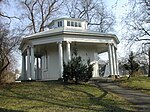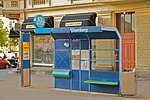Frogner Manor

Frogner Manor (Frogner Hovedgård) is a manor house and former estate in today's borough of Frogner in Oslo, Norway. The estate comprised most of the modern borough of Frogner, which has been named after the estate, and Frognerseteren with parts of the Nordmarka forest (Frognerseterskogen). The remaining part of the estate is now the site of the Frogner Park, with the manor house found in the south of the park and the Vigeland installation in the park's centre. The 18th century buildings on the grounds are now occupied by the Oslo City Museum. Frogner was one of the largest and oldest agricultural properties in the Oslo area. In the Middle Ages, Frogner became ecclesiastical property, mostly owned by the Hovedøya Abbey, but was confiscated by the Crown in 1532, preceding the Reformation. From the mid 17th century to the late 19th century, it was owned by wealthy officials or burghers of Christiania, but it was sold to the municipality of Kristiania in 1896 to make room for urban expansion and a new cemetery (Vestre gravlund). However, significant parts of the estate instead became a public park.
Excerpt from the Wikipedia article Frogner Manor (License: CC BY-SA 3.0, Authors, Images).Frogner Manor
Halvdan Svartes gate, Oslo Frogner
Geographical coordinates (GPS) Address External links Nearby Places Show on map
Geographical coordinates (GPS)
| Latitude | Longitude |
|---|---|
| N 59.924280555556 ° | E 10.70305 ° |
Address
Frogner hovedgård
Halvdan Svartes gate
0267 Oslo, Frogner
Norway
Open on Google Maps








